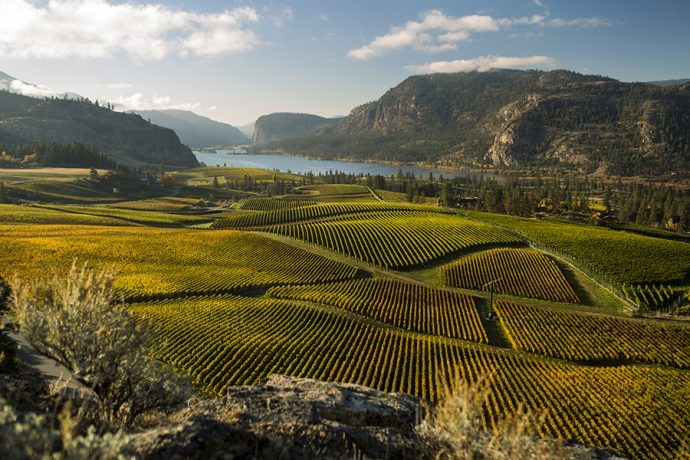Along with a dynamic, young prime minister and a buzzed about Broadway show, “Come From Away,” (see cover story), Canada boasts a burgeoning wine industry — especially in British Columbia.
“This is an exciting time for wines of British Columbia as we build an international reputation for our fresh, bright, quality wines and premium tourism destination,” says Laura Kittmer, media relations manager of the British Columbia Wine Institute. “2016 was a record-breaking year for wine tourism in British Columbia, welcoming more than one million visitors to our world-class wine region, and the industry continues to grow.”
British Columbia abuts Washington state and is in the running for the most beautiful natural wine region of the world. It has the Pacific Ocean; it has rivers and lakes everywhere; and it has mountains, including some of best skiing and boarding destinations on the planet, like Revelstoke, Kicking Horse and Whistler Blackcomb. But the mountains of BC aren’t just majestic. They contribute to the quality of the wine production. There are four parallel mountain ranges in BC. The Coast and the Cascade mountain ranges create a rain shadow in the regions to the east of them. The mountains intercept weather and cause dry, almost desert-like conditions to the east. Additionally, through volcanic and glacial action, the soils are attractive for making nuanced, high quality wines capable of significant aging.
There are currently five geographical wine regions in British Columbia, with the Okanagan Valley and Similkameen contributing 90 percent of the province’s wines. In 1974, the Canadian government planted 4,000 vines to see which varietals were viable in this unique landscape. In 1984, there were just 13 wineries. In 1995, there were 30. By 2011, there were 200 and today there are more than 275 wineries. Most of the grape types are of the noble varietals, grapes most everyone would recognize. Red grapes grown are Merlot, Pinot Noir, Cabernet Sauvignon, Cabernet Franc, Syrah and Gamay. Whites you will find are Pinot Gris, Chardonnay, Gerwürztraminer, Riesliing, Sauvignon Blanc and Viognier. Wine production contributes $2.8 million to the local economy so it’s likely their production is only going to increase in quality and quantity.
I recently had the opportunity to meet several British Columbian winemakers and taste their wines against the backdrop of an amazing multicourse seafood luncheon prepared by chef Ned Bell of Vancouver in the James Beard House in Manhattan. The food was truly extraordinary and showcased each of the specifically paired wines. We started with a Steller’s Jay Brut sparkling wine. It showed good citrus, lively bubbles and a persistent finish. Made in the traditional (Champenoise) method, it will hold up to sparkling celebration wines from anywhere.
Next we tasted an organic Riesling from Little Farm Winery. It was dry and pleasant and soft on typical Riesling flavors. Our next wine was an unmistakable Chardonnay from Black Hills Estate. This wine has a lovely citrus component carried by a nuanced oak influence, giving it layers and texture. Then we were served a Bordertown Vineyards & Estate Winery Cabernet Franc, which was rich and lovely, with red cherry and big floral notes and good mouthfeel. This was followed by Syrah from Poplar Grove Winery. It showed dark cherry, with a great spiciness and pepper, its aromas jumping out of the glass. Our last pour was a Bench 1775 Winery 2014 Viognier ice wine. This a gorgeous dessert wine with great balance of lemon citrus vanilla and honey with an unctuous mouthfeel. Simply delicious.
Equally worthy are wines from Inniskillin, Mission Hill Winery, Jackson-Triggs Winery and Foxtrot Vineyards, which I have visited in the past.
Traveling to Europe is wonderful, magical and unforgettable. But it takes effort to get there. Visiting British Columbia is considerably easier, with flights to Seattle, Vancouver or any number of other airports. If a visit is beyond reach, pick up some of these wines from a well-stocked purveyor. The wines are wonderful and will only improve with each passing vintage as the vines mature. Count me in.
Write me at doug@dougpaulding.com.


